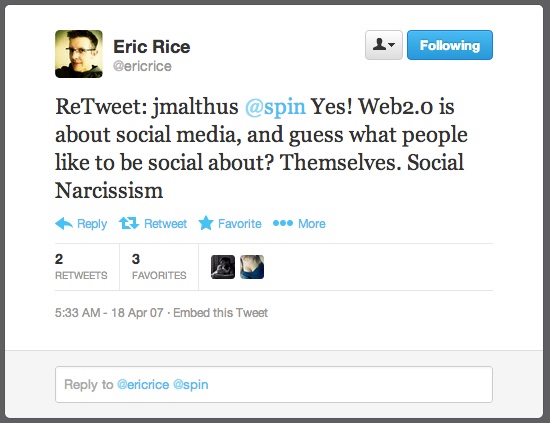On November 05, 2009 Twitter started a limited rollout of the ‘retweet’ feature to its users. The practice of retweeting has been invented two years earlier by Twitter community and the first ReTweet is often attributed to user Eric Rice. He is said to have coined the term ‘ReTweet’ on 18 April 2007:
Rice’s ReTweet would soon be shortened to RT due to Twitter’s 140-character limit and the practice of retweeting was quickly adopted by other users, third-party application developers and eventually by Twitter itself. Users and third-party apps developed their own retweet practices. Most commonly the whole tweet would be copy pasted and prefixed with RT @username (of the original poster) but some users would modify the retweet slightly by editing it so it would fit the 140-character limit. This also gave rise to the ‘fake retweet’ by pretending to retweet an existing tweet, but instead, this tweet would be newly created. Such fake retweets often concern celebrities, where users will impersonate celebrities by creating (humorous) fake retweets. In addition, these fake retweets were used by spammers by including spammy links in the tweets to trick users into thinking a reliable account had sent out that link, and therewith posed a security problem for Twitter.
In August 2009 Twitter announced the initial steps in the implementation of the retweet as a ‘native’ feature of the platform in a blogpost which explicitly referred to the adoption of a practise developed by its users.
Some of Twitter’s best features are emergent—people inventing simple but creative ways to share, discover, and communicate. One such convention is retweeting. When you want to call more attention to a particular tweet, you copy/paste it as your own, reference the original author with an @mention, and finally, indicate that it’s a retweet. The process works although it’s a bit cumbersome and not everyone knows about it.
Retweeting is a great example of Twitter teaching us what it wants to be. The open exchange of information can have a positive global impact and the more efficient dissemination of information across the entire Twitter ecosystem is something we very much want to support. That’s why we’re planning to formalize retweeting by officially adding it to our platform and Twitter.com. (@Biz)
This is also how many features in blog software became formalized and standardized such as the permalink which was created by bloggers to create a permanent URL for a blog entry, and was implemented after other bloggers openly requested such persistant references for their blogposts in their blog software (Helmond 2008). After Twitter adopted the user practice of retweeting and implementing it as a ‘native’ feature in their platform they added a retweet icon to their web interface and tweets could now be retweeted with a single click. This tweet would be integrally retweeted and created a verbatim copy, eliminating the possibility to create fake retweets. However, some users would continue to manually create (fake and real) retweets, but more importantly, third-party apps offered a variety of retweet mechanisms. Some apps would automatically add RT in front of a retweeted tweet and allow modification, while others would “quote” a tweet to indicate a retweet. While we can now visually distinguish between native retweets and non-native (potential fake) retweets it is important for researchers to note that there is no such thing as a singular type of retweet.

When doing Twitter analysis which relies on retweets it is important to keep in mind that users, third-party software and Twitter itself produce and offer distinct types of retweets (see also: Burgess and Bruns 2012). Twitter only returns their own native retweets through their API:
Note: Retweets may appear differently in third-party applications, and will show up in apps only if they are using Twitter’s retweet API. Many apps have built in their own version of retweeting — those Tweets are not treated as official retweets on Twitter. To test, try retweeting from your favorite app, then check your profile on the web. (FAQs About Retweets (RT))
Thus, when doing a form of retweet analysis one should take the historical background of the retweet into account with its various user practices and uptake by third-party applications. Conducting retweet analysis using the Twitter API means that other types of retweets will be excluded from the analysis, which should be noted in the research design.

Dear Anne,
nice post on retweets. I believe Twitter acknowledges somewhere the limitations of their API regarding the retweets. I did an analysis some time ago, identifying API retweets and extracting it from the tweets themselves. There is a bias of about 2.8 percent. See http://blog.mauricevergeer.nl/2011/04/18/bias-in-twitter-api-measurements/